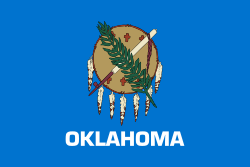2nd Oklahoma Legislature | |
|---|---|
 | |
| Leadership | |
Ben Wilson (D) | |
Composition: | |
The Second Oklahoma Legislature was a meeting of the legislative branch of the government of Oklahoma, composed of the Oklahoma Senate and the Oklahoma House of Representatives, during the only term of Governor Charles Haskell. State legislators elected in 1908 met in the Guthrie City Hall Building from January 5 to March 12, 1909. [1] The state legislature also met in special session from January 20 to March 19, 1910. [1]
Contents
- Dates of sessions
- Major legislation
- Party composition
- Senate
- House of Representatives
- Leadership
- Senate 2
- House
- Members
- Senate 3
- House of Representatives 2
- References
- External links
Oklahoma's first black state legislator, A. C. Hamlin, was among the new group of state legislators, but was limited to one term by a Jim Crow law passed by the legislature. [2]

